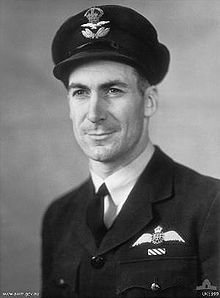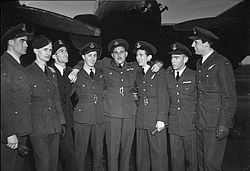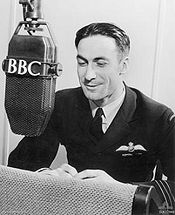- Charles Scherf
-
Charles Cunrow Scherf
Charles Scherf c. 1944Nickname "Last Trip"[1] Born 17 May 1917
Emmaville, New South Wales, AustraliaDied 13 July 1949 (aged 32)
Emmaville, New South Wales, AustraliaAllegiance  Australia
AustraliaService/branch  Citizens Military Force
Citizens Military Force
 Royal Australian Air Force
Royal Australian Air ForceYears of service 1934 – 1939
1941 – 1947Rank Squadron Leader Battles/wars Second World War
Awards Distinguished Service Order
Distinguished Flying Cross & BarCharles Curnow Scherf DSO, DFC & Bar (17 May 1917 – 13 July 1949) was an Australian flying ace of the Second World War. Born in New South Wales, Scherf was working on his father's grazing farm when he enlisted in the Royal Australian Air Force in 1941. Graduating as a pilot, he was transferred to the United Kingdom for service in the European theatre. Flying de Havilland Mosquitos with No. 418 Squadron RCAF, Scherf was credited with the destruction of 7½ aircraft, airborne and grounded, and awarded the Distinguished Flying Cross. Afterward, he was posted for duties with Headquarters Air Defence Great Britain. Despite this posting, he occasionally returned to No. 418 Squadron and flew operational sorties with the unit. During this time, he destroyed a further 16 aircraft and was decorated twice more. By the end of the war, Scherf was credited with 14½ aerial victories spread over 38 operational sorties. In addition to this, he was attributed with destroying nine aircraft that were grounded and with damaging seven others.
Contents
Early life
Scherf was born at Emmaville, New South Wales, on 17 May 1917, son of Charles Henry Scherf, a grazer, and his English wife Susan Jane (née Curnow). An active sportsman, Scherf attended the local school where he obtain an Intermediate Certificate. In 1934, he enlisted in the Citizens Military Force and was allotted to the 12th Light Horse Regiment as a private.[1][2] He later obtained the rank of corporal, before taking his discharge in 1939.[2] On 23 August 1939, Scherf married Florence Hope O'Hara in an Anglican ceremony at the Holy Trinity Church, Glen Innes; the pair would later have a son and three daughters. During this time, he was working as a grazer on his father's property.[1][2]
Second World War
On 12 September 1941, Scherf enlisted in the Royal Australian Air Force for service during the Second World War.[3] Posted for flight training at No. 10 Empire Flight Training School, Temora and later No. 6 Service Flying Training School, Mallala, he graduated as a pilot with an "above average" rating on 2 July 1942.[1][2] Commissioned as a pilot officer on 17 September, Scherf embarked from Sydney bound for the United Kingdom the following month. Following a six-week voyage, he disembarked on 27 November and was attached to Royal Air Force training units for "advanced flying and operational training". He was promoted to flying officer during this time. On completion, Scherf was posted to No. 418 Squadron RCAF on 13 July 1943, flying de Havilland Mosquito light bombers.[1][2]
In August 1943, Scherf commenced flying operational sorties against Axis airfields in France. On 15 September, he flew as an escort to a group of eight Lancaster bombers during a low level attack on the Dortmund-Ems Canal, Germany.[1] He was promoted to acting flight lieutenant on 29 December.[1][2] During this time, Scherf took part in several night operations and was credited with damaging a variety of targets as well as shooting down four German aircraft at night. Praised for his "exceptional keenness and ... courage", Scherf was subsequently awarded the Distinguished Flying Cross for his night time exploits. The announcement and accompanying citation for the award was published in a supplement to the London Gazette on 4 April 1944.[4]
During late February 1944, Scherf took part in a sortie over Axis occupied territory with Squadron Leader Howie Clevelend; Scherf flew the leading aircraft of the two. The pair attacked an Axis airfield at St Yan, France, and successfully destroyed three aircraft on the ground. Soon after, the two pilots spotted a Heinkel He 111Z twin-fuselage glider tug towing two Gotha Go 242 gliders. Scherf and Clevelend attacked the party, with Clevelend firing first and destroying one of the gliders. Scherf then destroyed the second glider, before the pair assaulted the Heinkel. In the first pass, Scherf set the starboard engine ablaze while Clevelend hit the starboard side. Scherf made a second firing pass, before the Heinkel spiralled to the ground with three of its five engines on fire. This action was Scherf's final sortie of his tour.[5] The pair were consequently credited with shooting down three aircraft for their efforts in the operation, with an additional three others damaged or destroyed on the ground.[6]
On 13 March 1944, Scherf was promoted to acting squadron leader and, with his operation tour at an end, was posted to Headquarters Air Defence Great Britain as a controller of Intruder operations.[1][2][5] By the time of this posting, Scherf had destroyed seven airborne or grounded German aircraft, with an additional shared victory. Despite his new position, Scherf's "impatient spirit was far from satisfied with a staff position",[7] and he occasionally returned to No. 418 Squadron when he was off duty, taking part in operational sorties with the unit. On 5 April, Scherf joined the squadron in a sortie over Northern France. During the engagement, Scherf shot down two Axis aircraft in the air and damaged three more on the ground.[1][6][7] For his actions on the two operations in February and April, Scherf was awarded a Bar to his Distinguished Flying Cross. The citation for the decoration was published in a supplement to the London Gazette on 12 May 1944, reading:[6]
Air Ministry, 12th May, 1944The KING has been graciously pleased to approve the following awards in recognition of gallantry displayed in flying operations against the enemy —
Bar to Distinguished Flying Cross
Acting Flight Lieutenant Charles Curnow SCHERF, DFC (Aus 413671), Royal Australian Air Force, No 418 (RCAF) Squadron.
Since being awarded the Distinguished Flying Cross, this officer has taken part in numerous sorties and has continued to display the highest qualities of gallantry and skill. Towards the end of February, 1944, he flew the leading aircraft of two detailed for a sortie far in enemy occupied territory. During the operation three enemy aircraft were shot down, and three others damaged on the ground. During another sortie over Northern France in April, 1944, Flight Lieutenant Scherf destroyed two enemy aircraft in the air and damaged three others on the ground at an airfield. These 2 sorties were a fitting climax to an outstanding tour. This officer has destroyed at least 9 enemy aircraft, successes which pay an excellent tribute to his great fighting qualities and resolution.On 2 and 16 May 1944, Scherf took part in two further daylight sorties with No. 418 Squadron into "well-defended areas far into Germany".[1][8] Leading a section of Mosquito aircraft in action against Luftwaffe bases in the Baltic area and over northern Germany,[7] Scherf was ultimately credited with shooting down six aircraft in aerial combat, and damaging an additional three on the ground over the two operations. Commended for his "great skill, enterprise and fearlessness",[8] Scherf was subsequently awarded the Distinguished Service Order. The notification and accompanying citation for the decoration was published in a supplement to the London Gazette on 27 June 1944.[8]
On 10 July 1944, Scherf embarked from the United Kingdom in order to return to Australia. Arriving in Brisbane two months later, he was briefly posted to RAAF Station Sandgate. During October, Scherf was posted to No. 5 Operational Training Unit, Williamtown, as chief flying instructor. He served in this position until late December, when he was posted for duties with RAAF Base Richmond and later RAAF Bradfield Park. On 11 April 1945, Scherf transferred to Royal Australian Air Force Reserve and returned to his home in Emmaville; thus ending his wartime service. By this time, Scherf had been officially credited with shooting down 14½ Axis aircraft in aerial combat, as well as nine aircraft destroyed on the ground and a further seven damaged from a total of 38 operational sorties.[1][2]
Later life
On 16 February 1946, Scherf attended an investiture ceremony at Government House, Sydney, where he was presented with his Distinguished Service Order, Distinguished Flying Cross and Bar by the Governor-General of Australia, Prince Henry, Duke of Gloucester.[9][10][11] Scherf was discharged from the Royal Australian Air Force Reserve on 1 July 1947.[3]
Scherf found it difficult to re-adjust to civilian life, and began to have nightmares about the Germans he had shot down and killed during the war. This consequently led him to drink heavily. On 13 July 1949, Scherf was driving his car along the Inverell road approximately 3 kilometres (1.9 mi) from Emmaville when he struck a tree and the vehicle overturned; he died later that day from his injuries sustained during the crash. Survived by his wife, their three daughters and son, Scherf was buried in the local cemetery.[1]
Notes
- ^ a b c d e f g h i j k l McCarthy, John (2002). "Scherf, Charles Curnow (1917 – 1949)". Australian Dictionary of Biography. Canberra: Australian National University. http://www.adb.online.anu.edu.au/biogs/A160220b.htm. Retrieved 25 February 2009.
- ^ a b c d e f g h "Scherf, Charles Curnow : Service Number - 413671". Records Search. National Archives of Australia. http://naa12.naa.gov.au/scripts/imagine.asp?B=5248354&I=1&SE=1. Retrieved 25 February 2009.
- ^ a b "Scherf, Charles Curnow". World War II Nominal Roll. Commonwealth of Australia. http://www.ww2roll.gov.au/script/veteran.asp?ServiceID=R&VeteranID=1062703. Retrieved 25 February 2009.
- ^ London Gazette: (Supplement) no. 36453. p. 1552. 4 April 1944. Retrieved 25 February 2009.
- ^ a b Thomas 2005, pp. 64–65
- ^ a b c London Gazette: (Supplement) no. 36511. p. 2185. 12 May 1944. Retrieved 25 February 2009.
- ^ a b c Herington 1963, p. 24
- ^ a b c London Gazette: (Supplement) no. 36584. p. 3041. 27 June 1944. Retrieved 25 February 2009.
- ^ "Recommendation for Charles Curnow Scherf to be awarded a Distinguished Service Order" (PDF). Index to Recommendations: Second World War. Australian War Memorial. http://www.awm.gov.au/cms_images/awm192/00310/003100005.pdf. Retrieved 25 February 2009.
- ^ "Recommendation for Charles Curnow Scherf to be awarded a Bar to Distinguished Flying Cross" (PDF). Index to Recommendations: Second World War. Australian War Memorial. http://www.awm.gov.au/cms_images/awm192/00310/003100006.pdf. Retrieved 25 February 2009.
- ^ "Recommendation for Charles Curnow Scherf to be awarded the Distinguished Flying Cross" (PDF). Index to Recommendations: Second World War. Australian War Memorial. http://www.awm.gov.au/cms_images/awm192/00310/003100007.pdf. Retrieved 25 February 2009.
References
- Herington, John (1963) (PDF). Volume IV – Air Power Over Europe, 1944–1945. Australia in the War of 1939–1945. Canberra, Australia: Australian War Memorial. http://www.awm.gov.au/histories/second_world_war/volume.asp?levelID=67915. Retrieved 22 September 2009.
- Thomas, Andrew (2005). Mosquito Aces of World War 2. Oxford, England: Osprey Publishing. ISBN 1841768782.
Categories:- 1917 births
- 1949 deaths
- Australian aviators
- Australian Army soldiers
- Australian World War II flying aces
- Companions of the Distinguished Service Order
- People from New South Wales
- Recipients of the Distinguished Flying Cross and Bar (United Kingdom)
- Road accident deaths in Australia
- Royal Australian Air Force officers
Wikimedia Foundation. 2010.



